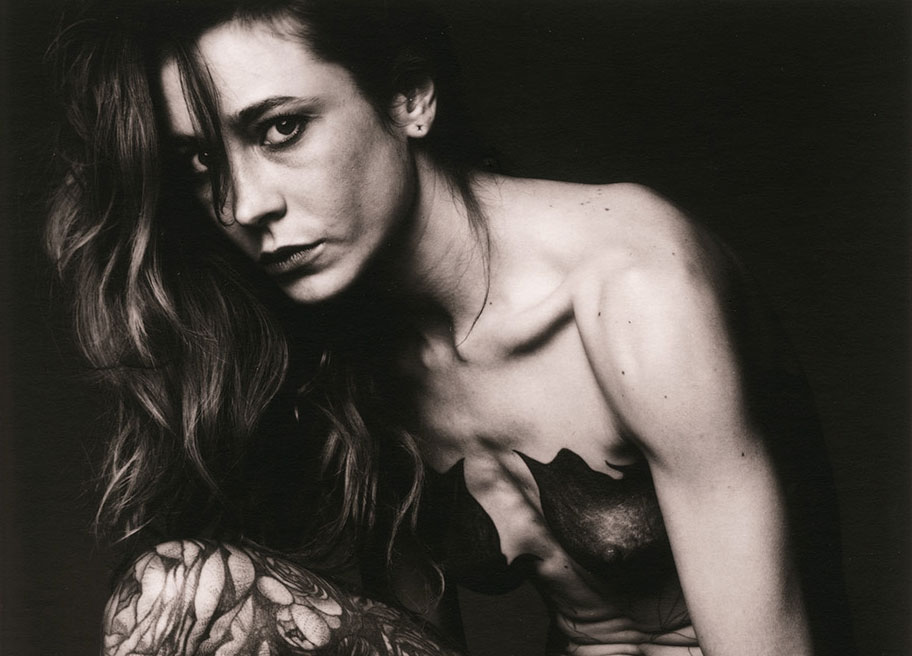Alessio Delfino returns to exhibit choosing Basel, a privileged place for art, and Gregor Muntwiler’s Eulenspiegel Gallery, with whom he has recently built a relationship based on sensitivity and mutual appreciation.
After several years dedicated to research and the study of themes such as identity, the body, and the self – during which the artist deliberately distanced himself from exhibition venues – Delfino now unveils his unpublished works, almost as if opening the door to a true Wunderkammer, where the protagonists are not found or recovered objects, but portraits of women, friends, and acquaintances encountered throughout his personal and professional life.
A cabinet of curiosities understood in a philosophical sense: as a tension, a desire for knowledge, and an ontological wonder that leads to exploring the mystery of life.
Like an anthropologist, Delfino has spent these years using the photographic language – his preferred means of expression – to investigate the relationship between people and their bodies, creating a nearly scientific catalog of images capturing the essence of his subjects.
Driven by the need to solve the enigma of what kind of relationship exists between a person and their body, Delfino explores the female individual not as a biological entity, but as a fusion of the psychological and biological person. He reflects on the space of recognition within the “between” – conceived as a space of thought on which to base and build a classification aimed at understanding humanity in its entirety. Secretaries, circus artists, fetish models: all are unique presences resulting from unrepeatable encounters that reveal to the artist their deepest identity.
It is a field-based investigation built on observation and confrontation with otherness, generating a hermeneutic circularity founded on dialogue – between observer and observed, between artist and model. This relational process does not claim or expect to offer answers, but rather raises questions about individual and collective identity, while also providing a space for critical reflection on society.
These female portraits are created using a large-format camera, a tool that allows Delfino to establish a deep connection with his models – turning each shot into a cathartic gesture intended to deepen the experience.
A technical and poetic choice that takes on an almost political significance today: the decision to work with analog photography, to shoot with a large-format camera, and to personally develop and print his images. In the era of artificial intelligence, deepfakes, and limitless digital manipulation, Delfino’s gesture becomes one of resistance – a reaffirmation of reality, of substance, of time.
Each photograph is the result of a real presence, an unrepeatable encounter, and a shared responsibility between photographer and subject. Analog becomes not just a formal choice, but a practice of truth: a return to the essential in a society overloaded with disembodied images, faces without depth, and simulacra that never had an origin.
With this new series, Delfino continues his investigation into image and identity, leading the viewer into the heart of a rigorous and lucid aesthetic vision, where every element – from the light to the skin detail – seems called upon to reveal the subject’s true essence.
The contact prints on baryta cardboard, selenium-toned and then sepia-toned, convey a timeless, material impression, enhancing the absolute presence of the bodies and faces depicted.
Yet this is not merely a mimetic rendering of reality: in Delfino’s work, the image is always an epiphany, a surface that both veils and reveals – through transparency and fading – a portal to an ontological elsewhere that is never fully reachable, ineffable and elusive, repelling and seducing, constantly teetering between sudden revelation and eternal unknown.
Viana Conti writes of him: “Delfino’s deep interest in photography and darkroom techniques led him from a young age to explore its various possibilities through his studies in chemistry. From his earliest works, he chose to direct his artistic research toward the creation of photographic series, rather than synthesizing it into a single image. He does not aspire to the ‘decisive moment’ in the sense of Henri Cartier-Bresson, but pursues a quasi-cinematic representation of the passage of time through images that seemingly evoke its relentless nature and thus cannot be reduced to a single shot.”
You are invited to enter the marvelous Wunderkammer of Alessio Delfino, to experience what can almost be described as a temporal leap – transporting us back to an era when humanism stood at the center of cultural and artistic interest.
Christine Enrile
